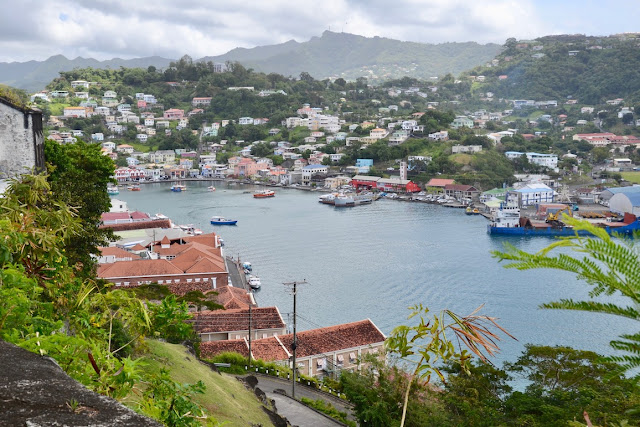For more than 350 years, Fort George has guarded the Carenage (harbour front) of St Georges, Grenada’s principal city. Built by the French as Fort Royal, renamed Fort George by the British after King Georges III, and briefly renamed Fort Rupert in the early 80’s, it has stood watch over Spanish gold, the trade in African slaves, and the Spice Island’s export trade.
It’s an impressive building that dominates the part of the island that lies between the Caribbean and the harbour. We had to park in its shadow and walk all the way up the hill and then climb between the gap in the walls to find the entrance. It was a hot day - we were glad it was only March. Then, you pay your entrance fee and you are on your own as you wander through the tunnels and roofless structures.
The cast-iron cannons that face the sea date from the 1800’s and are said to be in working order but it’s the Fort’s more recent history that marks it as a local shrine. Grenada achieved independence from Great Britain in 1974 and transitioned to an elected democracy under Prime Minister Eric Gairy. But his rule was plagued with controversy and allegations of intimidation. In 1979, Maurice Bishop leader of the left-wing New JEWEL Movement (NJM) overthrew Gairy’s government and ruled by decree, with policies that moved toward equality for the African majority and women, making him a local hero. One of his first acts was to rename Fort George, Fort Rupert, after his father.


Much of the Fort is a little neglected – vegetation in the lighthouse made it difficult to enter.
A faction of NJM, led by Bishop’s childhood friend Bernard Coard, wanted Grenada to emulate Cuba – a communist regime supported by the USSR, but Bishop resisted, even as Cuba helped the NJM to build a new international airport near St George’s (Point Salines Airport). The US perceived this airport as a military base increasing the Soviet threat in the Caribbean.
 The NJM government gradually split apart. Then, on 19 October 1983, Maurice Bishop and six of his cabinet were arrested and taken to the courtyard in Fort Rupert, where they were executed by firing squad, or obliterated as witnesses related, in an incident that saw more than 20 military and civilian personnel loyal to Maurice Bishop massacred.
The NJM government gradually split apart. Then, on 19 October 1983, Maurice Bishop and six of his cabinet were arrested and taken to the courtyard in Fort Rupert, where they were executed by firing squad, or obliterated as witnesses related, in an incident that saw more than 20 military and civilian personnel loyal to Maurice Bishop massacred.
It was a chilling moment when I came upon a commemorative plaque in the courtyard, attached on the wall surrounded by bullet marks. I had to admit I didn’t realize that this had taken place here.
 As we reached the highest level of the fort, we came upon two guys singing calypsos and they invited us to join them. Carol found her voice and they sang in ‘Island in the Sun’ – it lifted our spirits for the walk back down the hill, as we remembered singing along to Harry Belafonte in the 60’s.
As we reached the highest level of the fort, we came upon two guys singing calypsos and they invited us to join them. Carol found her voice and they sang in ‘Island in the Sun’ – it lifted our spirits for the walk back down the hill, as we remembered singing along to Harry Belafonte in the 60’s.






The massacre is a sombre note on that island.
ReplyDelete